Introduction of Rose:Rose petals, Rose Oil and Rose Water.
-
 ✵The article gives records of the herb Rose, its English name, Latin name, common names, property and flavor, its botanical source two plant species, ①.Rosa gallica L., ②.Rosa centifolia., with a detailed introduction to the botanical features of these two plant species, the growth characteristics, and ecological environment of these two plant species, the features of the herb Rose, its pharmacological actions, medicinal efficacy, and administration guide.
✵The article gives records of the herb Rose, its English name, Latin name, common names, property and flavor, its botanical source two plant species, ①.Rosa gallica L., ②.Rosa centifolia., with a detailed introduction to the botanical features of these two plant species, the growth characteristics, and ecological environment of these two plant species, the features of the herb Rose, its pharmacological actions, medicinal efficacy, and administration guide.
- Rose(Rose Oil,Rose Water).
-
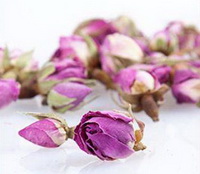 English Name: Rose, Rose Oil, Rose Water.
English Name: Rose, Rose Oil, Rose Water.
Latin Name: Rosa gallicia and Rosa centifolia.
Common Names: Cabbage Rose, Damask Rose, French Rose, Hundred-Leafed Rose.
Property and flavor: light fragrance, tastes clear and sweet.
Brief introduction: Rose fresh flowers are harvested early in the morning when their essential oil content is the highest, and then subjected to steam distillation to produce a yellow-green oil. Rose water is the watery portion left over.
Botanical source: Common herbal classics defined the herb Rose as the dried fruit of the species (1). Rosa gallica L., (2). Rosa centifolia. They are plant species of the Rose genus, the Rosaceae family (rose family). The dried petals are used medicinally. This commonly used species is introduced:(1).Rosa gallica L.
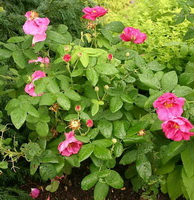 Botanical description: Rosa gallica is the common latin name of Rosa × gallica L. It is also known as Rosa rubra or French Rose. Rosa gallica is an upright shrub, it grows up to about 1.5 meters high; branchlets usually have thorns of varying sizes and mixed bristles; leaflets 3~5; leaflets are coriaceous, ovate, or broadly elliptic, 2~6 cm long, the apex is rounded blunt or short tapering, the base is rounded or nearly cordate, with double serrations, rarely single serrations, tooth tips are often glandular, dark green on the upper surface, folded, light green at the back surface, pubescent; petioles and rachis have prickly and glandular hairs; stipules mostly adnate to petioles, the free part is ovate, margins with glandular hairs.
Botanical description: Rosa gallica is the common latin name of Rosa × gallica L. It is also known as Rosa rubra or French Rose. Rosa gallica is an upright shrub, it grows up to about 1.5 meters high; branchlets usually have thorns of varying sizes and mixed bristles; leaflets 3~5; leaflets are coriaceous, ovate, or broadly elliptic, 2~6 cm long, the apex is rounded blunt or short tapering, the base is rounded or nearly cordate, with double serrations, rarely single serrations, tooth tips are often glandular, dark green on the upper surface, folded, light green at the back surface, pubescent; petioles and rachis have prickly and glandular hairs; stipules mostly adnate to petioles, the free part is ovate, margins with glandular hairs.
Flowers are solitary, sparsely 3~4, without bracts; pedicels are upright and stout, glandular-hairy; flowers are 4~7 cm in diameter; flower tube and sepal outside have glands, sepal often with many lobes; petals are pink or dark red. Fruit is subsphaeroidal (torulose) or pear-shaped, bright red, sepals shed.
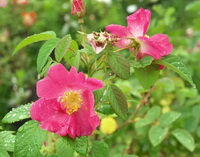 Ecological environment: Rosa gallica is native to central to Southern Europe, east to West Asia, Turkey, and the Caucasus. It is cultivated all over China. The cultivation of the French rose has a long history and there are many horticultural varieties. There are varieties of double and semi-double valves. The plant likes to grow in the bushes on roadsides, fields, or hills and can endure the winter in the open field in an environment with the lowest temperature of -25 °C (Celsius, or -13 degrees Fahrenheit).
Ecological environment: Rosa gallica is native to central to Southern Europe, east to West Asia, Turkey, and the Caucasus. It is cultivated all over China. The cultivation of the French rose has a long history and there are many horticultural varieties. There are varieties of double and semi-double valves. The plant likes to grow in the bushes on roadsides, fields, or hills and can endure the winter in the open field in an environment with the lowest temperature of -25 °C (Celsius, or -13 degrees Fahrenheit).
History story of French rose: French rose is generally used as a flower sauce, it was also used in ancient Europe to exorcise evil spirits. There are only a few species of the Rosa genus that can be said to be gorgeous. The species of deep color are Rosa gallica and Rosa rugosa. The Rosa gallica or red rose has a high status in European literature and is often associated with myths and legends. It is also the family emblem of the Lancaster family in the War of the Red and White Roses (Wars of the Roses, between 1455~85, in English history, the series of dynastic civil wars whose violence and civil strife preceded the strong government of the Tudors. Fought between the houses of Lancaster and York for the English throne, the wars were named many years afterward from the supposed badges of the contending parties: the white rose of York and the red rose of Lancaster.).(2).Rosa centifolia.
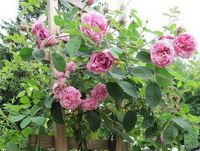 Botanical description: Rosa centifolia is a loose small shrub, it grows up to 2~3 meters high; the twigs have prickles of various sizes; the leaves are drooping, with 5~7 leaflets; the protruding part is rough, stalked, but without thorns. Leaflets are thin, oblong, the apex is tapering, the base is rounded or subcordate, margins are usually single-serrated, glabrous or occasionally piliferous on the surface, pubescent on the back surface; petioles and rachis are with glandular hairs; stipules are most adnate to petioles, the free part is ovate, the edge is glandular.
Botanical description: Rosa centifolia is a loose small shrub, it grows up to 2~3 meters high; the twigs have prickles of various sizes; the leaves are drooping, with 5~7 leaflets; the protruding part is rough, stalked, but without thorns. Leaflets are thin, oblong, the apex is tapering, the base is rounded or subcordate, margins are usually single-serrated, glabrous or occasionally piliferous on the surface, pubescent on the back surface; petioles and rachis are with glandular hairs; stipules are most adnate to petioles, the free part is ovate, the edge is glandular.
Flower buds are roughly oval, the first flowers blooming in late June or July, flowers are solitary or rarely fascicled, ebracteate, often double, fragrant; translucent pink from curvature of petals, very double, goblet-shape, completely looser when blown, revealing tightly packed petals. The pedicel is slender, curved, densely glandular-hairy; sepals are ovate, the apex is inconspicuously leaflike, lobes spread, longer than buds, and covered by pedicels and buds, like pedicels and buds, with sticky aromatic glands. Petals are pink; the style is free and piliferous. Fruit is round or oval, with pulpose pulp. Sepals are persistent.
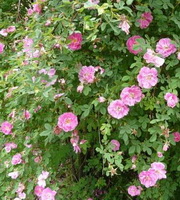 Ecological environment: Rosa centifolia is native to the Caucasus area, cultivated in Europe for a long time, there are many varieties, and it is not easy to distinguish it from the French rose varieties. This species has strong growth potential, wide and thin leaves, thornless leaf axis, flowers are often double, fragrant, slightly drooping, attached to long curved pedicels, and petals are upright and overlapping like cabbage; fruit is nearly spherical or oval shape, with persistent sepals and different from French rose. It is mainly produced in Europe and West Asia, it is also cultivated in China.
Ecological environment: Rosa centifolia is native to the Caucasus area, cultivated in Europe for a long time, there are many varieties, and it is not easy to distinguish it from the French rose varieties. This species has strong growth potential, wide and thin leaves, thornless leaf axis, flowers are often double, fragrant, slightly drooping, attached to long curved pedicels, and petals are upright and overlapping like cabbage; fruit is nearly spherical or oval shape, with persistent sepals and different from French rose. It is mainly produced in Europe and West Asia, it is also cultivated in China.
Growth characteristics: Rosa centifolia likes sunshine, is also resistant to partial shade and is relatively cold-resistant. It is suitable for fertile and moist wetlands with good drainage. It can overwinter in the open field in most parts of northern China. The plant does not have strict soil requirements and is resistant to drought and barrenness, but it grows better in deep, loose, fertile, moist, and well-drained soil, and can also grow normally on heavy soil. Intolerant of water and humidity, avoid water logging.
History and varieties of Rosa centifolia: The flower form of Rosa centifolia has been known since ancient times, and it was mainly developed by Dutch breeders in the 17th century and French breeders in the 19th century. Like several other groups of ancient roses, many of the varieties obtained have disappeared. Rosa centifolia were created by mutating another rose family. It is a complex hybrid, possibly derived from Rosa, Musk rose, dog rose, and Turkic roses, and possibly from Rosa phoenicia. There is no recorded history of the creation of Rosa centifolia, but genetic studies conducted by Dr.Hearst have shown that it is not a species per se, but an expected and recently emerged hybrid. Charles de l'Écluse (Carolus Clusius,French Charles de L’Écluse or Charles de l’Escluse, 1526~1609, an important 16th-century horticulturalist, botanist who contributed to the establishment of modern botany.One of his last major written works was a flora of Spain and Portugal that featured 233 botanical woodcuts. It was published in 1576.) recorded that he observed an almost white rose with more than 120 petals in the year 1591, the England botanist Gerard (John Gerard,1545~1612,English herbalist,author of The Herball,or generall historie of plantes in 1597.) noted in the herbarium when it came to "Centifolia Rose", he also called it "The Great Dutch Rose". Linnaeus(Carolus Linnaeus, also called Carl Linnaeus, Swedish Carl von Linné, 1707~1778,, Swedish naturalist and explorer who was the first to frame principles for defining natural genera and species of organisms and to create a uniform system for naming them) named it Rosa × centifolia in the year 1753. Between the years 1580 and 1710, Dutch rose growers created more than 200 varieties of Rosa × centifolia.
There are mainly 3 varieties and 1 variety of Rosa centifolia, ①.Rosa centifoliavar.carnea, it was named by Dum.Cours., was named in the year 1811., ②.Rosa centifoliavar.kingstoniana, it was named by Dum.Cours., was named in the year 1811., ③.Rosa centifoliaf.muscosa, it was named by (Aiton) C.K.Schneid., was named in the year 1904., ④.Rosa centifoliavar.parvifolia, it was named by (Ehrh.) Rehder, was named in the year 1916.
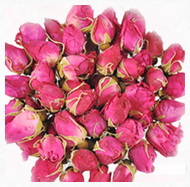 Characters of herbs: Rose flower is the dried petals of Rosa gallica and Rosa centifolia, collected before fully unfolding. The petals are harvested and dried in the shade.
Characters of herbs: Rose flower is the dried petals of Rosa gallica and Rosa centifolia, collected before fully unfolding. The petals are harvested and dried in the shade.
Roses contain a variety of trace elements, high content of vitamin C, roses can be eaten directly in some parts of Europe, rose rhizomes are boiled and eaten, and rose roots can be used to make wine. The ripe fresh fruits of roses contain a large amount of vitamin A, B, and C, as well as more than ten kinds of amino acids, soluble sugars, and alkaloids. Among them, the content of vitamin C is the most abundant, more than 2,000 mg per 100 grams, which is known as the "king of vitamin C". It also contains protein, fat, carbohydrate, calcium, phosphorus, potassium, iron, magnesium, etc., of which the protein content is 8.5%, the fat is 4.7%, the soluble sugar is 1.2%, and the carbohydrate is 68%. Rose dregs do not contain any harmful elements, including glucose 18.33%~23.66%, starch 21.75%~22.63%, and are rich in amino acids, the total amount of amino acids is as high as 10.9%. The rose red pigment is extracted from flower residues after distillation of rose oil for food coloring.
 Pharmacological actions: ①.refreshing and relieve depressive mood; ②.astringent; ③.anti-stress effect; ④.anti-skin aging effect, skin whitening and anti-skin wrinkle effect, skin anti-inflammatory activity; ⑤.cancer inhibition; ⑥.antioxidant and antimicrobial activity; ⑦.nephroprotective effect; ⑧.antiaging effects on lifestyle-related diseases. ⑨.antiarthritic activity, ⑩.rose oil activities.
Pharmacological actions: ①.refreshing and relieve depressive mood; ②.astringent; ③.anti-stress effect; ④.anti-skin aging effect, skin whitening and anti-skin wrinkle effect, skin anti-inflammatory activity; ⑤.cancer inhibition; ⑥.antioxidant and antimicrobial activity; ⑦.nephroprotective effect; ⑧.antiaging effects on lifestyle-related diseases. ⑨.antiarthritic activity, ⑩.rose oil activities.
Rose oil can lift a depressive mood, it has a refreshing property. Rose oil and rose water contain astringent components such as tannins, astringents help to heal the skin by tightening it, it has a reputation in cosmetics centuries ago and are still used for this purpose today.
Anti-skin aging effect: Rosa gallica has an anti-skin aging effect, and it could be used as a functional preparation against skin aging.
Skin whitening and anti-skin wrinkle effect: Rosa gallica petals exert skin whitening and anti-wrinkle activity. Rose gallica petals preparation is useful for skin whitening and anti-wrinkle cosmetics.
 Antioxidant and antimicrobial activity: Rosa gallica var. aegyptiaca leaf preparation shows antimicrobial activity against foodborne pathogenic bacteria-including Listeria monocytogenes, Bacillus subtilis, Staphylococcus aureus, Escherichia coli, and Salmonella enteritidis-and the fungus Candida albicans. Rosa gallica extracts are effective in promoting antioxidative and enzymatic inhibitory activities.
Antioxidant and antimicrobial activity: Rosa gallica var. aegyptiaca leaf preparation shows antimicrobial activity against foodborne pathogenic bacteria-including Listeria monocytogenes, Bacillus subtilis, Staphylococcus aureus, Escherichia coli, and Salmonella enteritidis-and the fungus Candida albicans. Rosa gallica extracts are effective in promoting antioxidative and enzymatic inhibitory activities.
Rose oil activities: rose oil has physiological and psychological relaxation, analgesic, and anti-anxiety effects, the rose oil is obtained from petals of Rosa centifolia L. and Rosa damascena Mill.
Medicinal efficacy: The herb Rose is approved for inflammation of the mouth and pharynx. In folk medicine, rose flowers are used for diarrhea, tuberculosis of the lungs, pulmonary catarrh and asthma, hemorrhage, and leukorrhea. In old preparations, rose was used as an astringent with healing properties. It is used externally for inflammations of the oral and pharyngeal mucosa, suppurating wounds, and lid inflammation. Rose oil is used by aromatherapists for calming nervous anxiety, rejuvenating the body and spirit, refreshing and lifting a depressive mood, and treating appetite loss, headache, and circulation problems. Rose water is used in a compress for sore eyes. Rose oil and water are widely used as fragrance components in perfumes, medicines, and various cosmetics. Low levels of rose oil are used as a fruity flavor component in foods and drinks, rose oil is also used in tobacco.
Administration of Rose (Rose Oil,Rose Water):
Reference: Administration Guide of Rose (Rose Oil,Rose Water) Herbal classic books: Dosage: Rose tea is prepared with 1 to 2 grams of herbs, add to 1 cup of water (about 200 m
